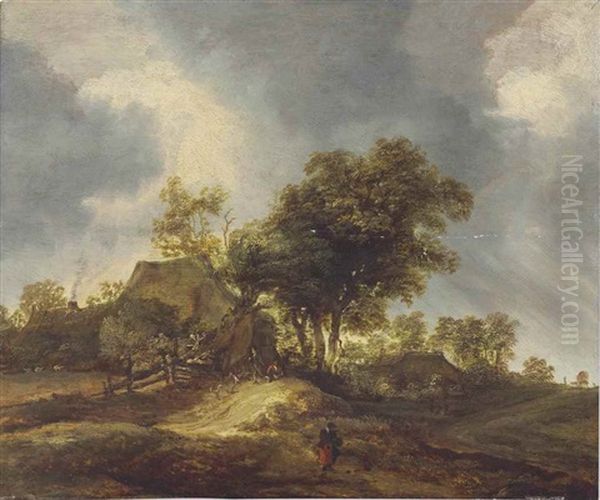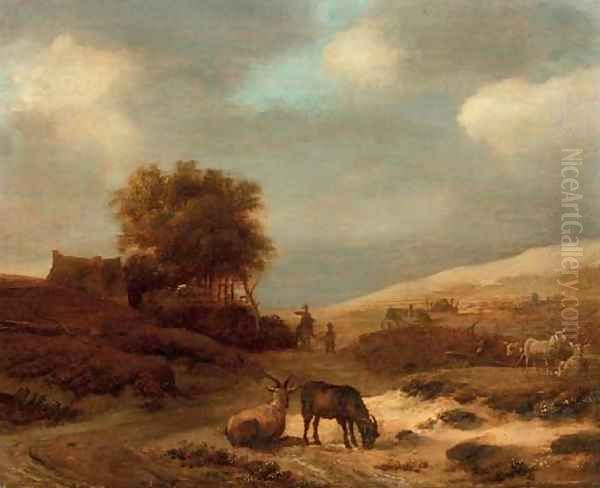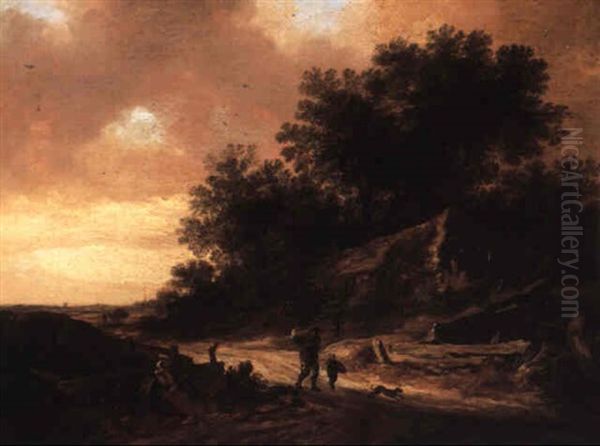The Dutch Golden Age, spanning roughly the 17th century, was a period of extraordinary artistic flourishing in the Netherlands. Amidst giants like Rembrandt and Vermeer, numerous highly skilled artists carved out significant niches, contributing profoundly to the development of various genres. Among these was Pieter de Molijn (1595-1661), a painter, printmaker, and draughtsman whose primary focus on landscape painting placed him at the forefront of a major stylistic shift towards naturalism. Though perhaps less universally known today than some contemporaries, Molijn was a respected figure in his time, an influential teacher, and a key innovator in the depiction of the Dutch countryside.
Early Life and Formative Influences
Pieter de Molijn's story begins not in the Netherlands, but in London, where he was born in 1595. His parents hailed from the Southern Netherlands, specifically the Flemish regions of Belgium and Brussels, likely having emigrated amidst the political and religious turmoil of the late 16th century. This background connected him to the rich artistic traditions of Flanders. While details of his earliest training remain somewhat obscure, it is known that he relocated to the Netherlands and, by 1616, had settled in the vibrant artistic center of Haarlem.
That year marked a crucial step in his professional life: he was accepted into the prestigious Guild of Saint Luke in Haarlem. Membership in the guild was essential for practicing artists, providing structure, regulation, and a network of peers. It is widely believed that during his formative years in Haarlem, Molijn may have studied with, or was significantly influenced by, Esaias van de Velde (c. 1587–1630). Van de Velde was himself an important transitional figure, moving away from the more artificial, Mannerist landscapes towards greater realism and local specificity, traits that would become hallmarks of Molijn's early work. Some accounts suggest Molijn might have undertaken a trip to Italy, a common practice for ambitious Northern European artists, though concrete evidence remains elusive. Regardless, his artistic foundations were firmly laid in Haarlem.
Establishing a Reputation in Haarlem

Molijn quickly established himself within Haarlem's competitive art scene. His talent and professional standing were recognized by his peers, leading to his election as dean (or vinder) of the Guild of Saint Luke on multiple occasions – records confirm his leadership in 1633, 1638, and 1646. This position underscored his respectability and influence within the local artistic community.
Beyond the guild, Molijn appears to have been a respected member of Haarlem society. He held positions such as deacon in the Dutch Reformed Church and served as a wijkmeester (block master) for the Crayenhorstgracht district, indicating civic engagement. His social standing was further cemented by an honorary commission from the Haarlem municipal authorities to paint landscape decorations for the city's church organ, a prestigious public project. He married Geertuyt Huygen de Bie, and together they raised a family. Following her death, records indicate he later remarried in Amsterdam. By the time of his death in Haarlem in 1661, he was considered a relatively wealthy and successful artist.
Pioneering the Tonal Landscape
Pieter de Molijn's most significant contribution to art history lies in his role as a pioneer of the "tonal phase" of Dutch landscape painting, which emerged around the mid-1620s. This represented a distinct move away from the brighter colours, intricate details, and often fantastical elements found in earlier Mannerist landscapes, exemplified by artists like Gillis van Coninxloo (1544–1607) or Roelandt Savery (1576–1639).
Molijn, alongside contemporaries like Jan van Goyen (1596–1656) and Salomon van Ruysdael (c. 1602–1670), began exploring a more naturalistic and atmospheric approach. His landscapes often feature a restricted, subtly modulated palette dominated by browns, greys, greens, and blues. He masterfully used these soft, harmonious tones and the interplay of light and shadow to create a powerful sense of depth, atmosphere, and spatial unity. Diagonal compositions, often featuring low horizons dominated by expansive, cloud-filled skies, became characteristic.
His paintings frequently depict the flat Dutch countryside, particularly dune landscapes near Haarlem, often populated with small figures – travellers, peasants, or soldiers – that add life and scale but rarely dominate the scene. A key work often cited as emblematic of this style is his Landscape with Dunes (sometimes titled Dune Landscape or similar variations, like Landscape with Dunes and Travelers), likely painted in the late 1620s. Such works capture the specific quality of light and the unassuming beauty of the local terrain with remarkable sensitivity, creating a distinctly Dutch sensibility. This tonal approach proved highly influential and popular.
Artistic Network: Contemporaries, Students, and Competitors

Molijn operated within a dense network of artistic relationships. His connection to Esaias van de Velde was foundational. His path frequently intersected with that of Jan van Goyen, another leading proponent of the tonal landscape. They shared stylistic concerns and likely influenced each other. While they were contemporaries and perhaps friendly rivals, evidence suggests a degree of market interaction; Molijn's works appeared in auctions connected to Van Goyen, indicating they navigated the same commercial waters.
Salomon van Ruysdael, another Haarlem-based master of the tonal landscape, was also a significant contemporary. Their styles share similarities, focusing on atmospheric depictions of the Dutch environment. Records even show Molijn and Salomon van Ruysdael collaborating on initiatives within the Guild of Saint Luke, such as advocating for new ways to sell affordable art through auctions and competitions.
Molijn was also a dedicated teacher, passing on his skills and style to the next generation. His most famous pupils include Gerard ter Borch the Younger (1617–1681), who would become renowned for his exquisite genre scenes and portraits (Molijn taught Gerard's father, Gerard ter Borch the Elder, as well), and Allart van Everdingen (1621–1675), who became known for his dramatic Scandinavian landscapes and seascapes. Jan Coenraetsz van Leeuwen is another documented pupil. Through these students, Molijn's influence extended well beyond his own lifetime. His position within the broader Haarlem context, an artistic hub that also included masters like the great portraitist Frans Hals (c. 1582–1666) and fellow landscapist Cornelis Vroom (c. 1591–1661), highlights the dynamic environment in which he worked.
Versatility Beyond Landscapes
While landscape painting was undoubtedly Pieter de Molijn's primary focus and area of greatest innovation, his artistic output was broader. Surviving works and historical records indicate his versatility, a trait common among artists of the period. He is known to have produced genre scenes (depictions of everyday life), marine paintings (seascapes), portraits, and even architectural studies.
This breadth reflects the demands of the 17th-century art market and the diverse skills expected of a master painter. While not typically categorized with the "Italianate" Dutch painters – those like Jan Both (c. 1618–1652) or Nicolaes Berchem (1620–1683) who specialized in idealized, sunny Italian landscapes – Molijn's willingness to tackle various subjects demonstrates his technical proficiency and adaptability. However, it was his landscapes that truly defined his career and secured his place in art history.
Market Acumen and Controversy

Pieter de Molijn was not just a talented artist but also possessed a keen understanding of the burgeoning Dutch art market. He adapted his production to meet different demands. While capable of producing more colourful, detailed, and presumably expensive works for discerning collectors, he recognized the growing appetite for more affordable art among the broader middle class. His development and popularization of the quicker-to-produce tonal, often monochrome, landscape style was partly a savvy market strategy.
This approach allowed him to create appealing works efficiently, making them accessible to a wider audience and ensuring a steady income stream in a competitive field. His collaboration with Salomon van Ruysdael on promoting sales through auctions further indicates his innovative thinking about distribution. However, his direct involvement in the market sometimes led to friction. There are records of local art dealers complaining about Molijn selling his own works directly at auction, viewing it as unfair competition that bypassed their role as intermediaries. This suggests an artist actively engaged in managing his career and finances. His success is attested by the appreciation of contemporary collectors and writers like Arnold Houbraken (1660–1719), who later chronicled the lives of Dutch painters.
Printmaking and Draughtsmanship
Beyond his paintings, Molijn was also active as a draughtsman and printmaker, particularly earlier in his career. Between roughly 1616 and 1625, he designed numerous prints, often landscapes, which were then engraved or etched by specialist printmakers. These prints helped disseminate his compositions and style more widely. His drawings, often executed with chalk or ink wash, reveal a confident hand and a keen eye for observation, capturing the structure of the land and the effects of light with spontaneity and vigour. These works on paper stand as important artistic statements in their own right, complementing his painted oeuvre.
Later Career and Evolving Legacy
During his lifetime, Pieter de Molijn enjoyed considerable success and was held in high regard, often mentioned in the same breath as Jan van Goyen as a leading landscape painter. His works were sought after by local Haarlem collectors as well as the urban elite in cities like Amsterdam. His influence, both direct (through students) and indirect (through the popularity of the tonal style he helped pioneer), was significant.

However, his reputation in subsequent art historical accounts has sometimes been overshadowed by artists perceived as more consistently innovative throughout their careers, such as Jacob van Ruisdael (c. 1629–1682), Salomon's nephew, who brought Dutch landscape painting to new heights of drama and grandeur. Some later critics suggested that Molijn's work after about 1630 became somewhat formulaic or overly reliant on the styles of Van Goyen and Salomon van Ruysdael, lacking the freshness of his earlier innovations. This assessment might partly explain why he features less prominently in some general surveys of Dutch art compared to his initial impact.
Nevertheless, this view perhaps underestimates his sustained quality and his crucial role during a pivotal moment in art history. His pioneering work in the 1620s was instrumental in shifting Dutch landscape painting towards the naturalistic, atmospheric style that would dominate for decades. He successfully captured the specific character of the Dutch environment and helped establish landscape as a major independent genre, reflecting national pride and a deep connection to the land. Even if some later works followed established patterns, his contribution as an innovator, a respected master in Haarlem, an influential teacher, and a commercially astute artist remains undeniable. His paintings continue to be appreciated for their subtle beauty, evocative atmosphere, and historical importance. He stands as a testament to the depth and richness of talent within the Dutch Golden Age, a period whose artistic achievements, even beyond the most famous names like Rembrandt, continue to fascinate and inspire.
Conclusion
Pieter de Molijn emerges from the historical record as a multifaceted and significant figure in 17th-century Dutch art. Born an outsider in London, he became a central figure in the Haarlem art world. As a painter, he was a key innovator, helping to forge the influential tonal style that defined Dutch landscape painting for a generation. His atmospheric and sensitive depictions of the local countryside resonated deeply with contemporary audiences. As a guild leader, teacher, and active participant in the art market, he shaped his environment and influenced numerous other artists, including notable figures like Gerard ter Borch the Younger and Allart van Everdingen. While his later reputation may have fluctuated, his foundational contributions to the Golden Age landscape genre, his technical skill across various media, and his role within the vibrant artistic community of Haarlem secure his place as an important master worthy of continued study and appreciation.